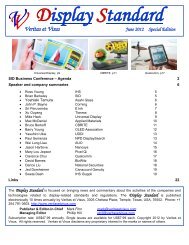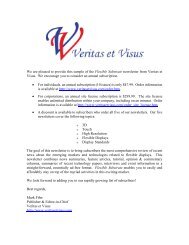Past Editions of “LCD TV Matters” - Veritas et Visus
Past Editions of “LCD TV Matters” - Veritas et Visus
Past Editions of “LCD TV Matters” - Veritas et Visus
Create successful ePaper yourself
Turn your PDF publications into a flip-book with our unique Google optimized e-Paper software.
LCD <strong>TV</strong> Association LCD <strong>TV</strong> Matters May 2012<br />
Haier shows <strong>of</strong>f compl<strong>et</strong>ely wireless 55-inch 3D<strong>TV</strong><br />
Haier Inc exhibited a large-screen 3D<strong>TV</strong> that features a wireless power transmission technology and does not<br />
have a power plug. In 2010, Haier showed a prototype <strong>of</strong> a 32-inch <strong>TV</strong> capable <strong>of</strong> being wirelessly powered. This<br />
time, it prototyped the <strong>TV</strong> by using a 55-inch LCD panel. The company is not planning to commercialize the <strong>TV</strong> at<br />
this point. Haier calls the latest prototype “compl<strong>et</strong>ely wireless <strong>TV</strong>" because not only electricity but video signals<br />
are wirelessly transmitted to the <strong>TV</strong>. The video signals are transmitted by using the WHDI (Wireless Home Digital<br />
Interface), the high-speed wireless transmission standard for high-definition video. As a wireless power<br />
transmission technology, Haier used the magn<strong>et</strong>ic resonance m<strong>et</strong>hod. Toshiba has also exhibited a tabl<strong>et</strong><br />
computer based on this m<strong>et</strong>hod. A power-receiving coil was located near the bottom <strong>of</strong> the <strong>TV</strong> while a powertransmitting<br />
device was stored in the box on which the <strong>TV</strong> was placed. The distance b<strong>et</strong>ween the bottom side <strong>of</strong><br />
the <strong>TV</strong> and the power-transmitting device was about eight inches (about 20cm). http://www.haier.com<br />
No cable is seen on the back side; A side view. The <strong>TV</strong> and the power-transmitting device are separated.<br />
MPEG LA <strong>of</strong>fers patent license for 3D video<br />
MPEG LA, an organization that licenses digital video technology patents on behalf <strong>of</strong> their owners, has announced<br />
terms for using a 3D video encoding technology called MVC. MVC (Multiview Video Coding) is used in Blu-ray disc<br />
players, personal computers, video cameras, s<strong>of</strong>tware, and other situations calling for 3D video. It is a codec, a<br />
specification for encoding and decoding video so it can be stored more compactly or streamed more efficiently<br />
across n<strong>et</strong>works. MPEG LA debuted the MVC license agreement terms at the Asia-Pacific 3D Standards & IP<br />
(Intellectual Property) Forum in Seoul, South Korea. For companies that want to use som<strong>et</strong>hing like MVC,<br />
licensing a patent pool is more convenient than hammering out agreements from a host <strong>of</strong> individual patent<br />
holders. But MPEG LA also licenses a patent pool for the widely used H.264 video codec. Google is trying to<br />
promote a royalty-free video codec called VP8 that comp<strong>et</strong>es with H.264, but MPEG LA is investigating wh<strong>et</strong>her to<br />
<strong>of</strong>fer a patent pool for VP8 and says so far it's found 12 organizations with patents that bear on VP8. Building the<br />
MVC technology for 3D video into a Blu-ray player will cost 10 cents per device, and selling discs costs a penny<br />
each, according to newly released licensing terms. For MVC, there are a vari<strong>et</strong>y <strong>of</strong> ways to pay for the patent<br />
license, each m<strong>et</strong>hod limited to a maximum <strong>of</strong> $6.5 million annually: a payment <strong>of</strong> 10 cents per unit for products<br />
that include MVC; a payment <strong>of</strong> 1 cent per Blu-ray disc or 1 percent <strong>of</strong> the price, whichever is lower, though titles<br />
shorter than 12 minutes are free; various payments for subscription services to with an unlimited number <strong>of</strong> titles<br />
using MVC, ranging from free for services with less than 100,000 annual subscribers to $300,000 for services with<br />
more than 25 million annual subscribers. A sizeable list <strong>of</strong> organizations hold patents essential to using MVC,<br />
MPEG LA said: Dolby Laboratories; Fraunh<strong>of</strong>er; Fujitsu; Hewl<strong>et</strong>t-Packard; Hitachi; Koninklijke; LG Electronics;<br />
Mitsubishi Electric Corporation; Nippon Telegraph and Telephone Corporation (NTT); NTT Docomo; Panasonic;<br />
Sharp; Sony; Columbia; and Thomson Licensing. http://news.cn<strong>et</strong>.com/8301-30685_3-57385106-264/mpeg-la<strong>of</strong>fers-patent-license-for-3d-video/#ixzz1ngvgbSqV<br />
12






